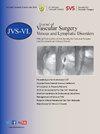Iliac venous stenting provides long-term relief from chronic pelvic pain
IF 2.8
2区 医学
Q2 PERIPHERAL VASCULAR DISEASE
Journal of vascular surgery. Venous and lymphatic disorders
Pub Date : 2025-01-01
DOI:10.1016/j.jvsv.2024.101993
引用次数: 0
Abstract
Objective
Iliac venous obstruction has been reported as a cause of chronic pelvic pain (CPP), however, there is a paucity of data in the literature reporting outcomes of venous stenting in this population. This study reports on a group of women with CPP and evidence of iliac venous obstruction: (1) the long-term impact of iliac vein stenting on pain scores; (2) the associations of age, stenosis severity, and concurrent presence of ovarian vein reflux (OVR) on pain; and (3) the effect of pregnancy after stenting.
Methods
We conducted a retrospective analysis of prospectively collected data of women with chronic pelvic pain who subsequently underwent iliac vein stenting. Data analyzed included demographics, venous measures (iliac and ovarian veins), visual analog scales, and pregnancy after stenting.
Results
A total of 113 female patients who had a history of chronic pelvic pain and underwent iliac venous stenting were included in analyses. The mean age at the time of stenting was 46.5 ± 15.7 years (range, 17-88 years). The baseline left common iliac vein diameter on duplex was 0.43 ± 0.18 cm and left common iliac vein area stenosis on intravascular ultrasound was 77.4 ± 9.4%. The baseline pain severity was correlated with younger age, degree of stenosis and presence of OVR. At a median follow-up of 5 years after stenting, 98% had improved pain scores and 73% had complete resolution of their pain despite the presence of residual OVR. Pregnancy after stenting did not result in the recurrence of pain and there were no stent-related complications with pregnancy.
Conclusions
Iliac venous stenting provides long-term relief from CPP even with residual OVR and poststent pregnancy. With 73% of women having full pain resolution, and the rest having a mean residual pain score of <3, this study supports venous stenting for the treatment of CPP of venous origin, especially in young women.
髂静脉支架植入术可长期缓解慢性盆腔疼痛。
目的:据报道,髂静脉阻塞(IVO)是导致慢性盆腔疼痛(CPP)的原因之一,然而,文献中有关该人群静脉支架治疗效果的数据却很少。本研究报告了一组有 IVO 证据的 CPP 妇女:i) 髂静脉支架置入术对疼痛评分的长期影响;ii) 年龄、狭窄严重程度和同时存在的卵巢静脉反流 (OVR) 对疼痛的影响;iii) 支架置入术后怀孕的影响:方法:对前瞻性收集的慢性盆腔疼痛妇女的数据进行回顾性分析,这些妇女随后接受了髂静脉支架植入术。分析数据包括人口统计学、静脉测量(髂静脉和卵巢静脉)、视觉模拟量表以及支架植入术后的妊娠情况:共有 113 名有慢性盆腔疼痛病史并接受过髂静脉支架植入术的女性患者参与了分析。支架植入时的平均年龄为 46.5 ± 15.7 岁(范围:17 - 88 岁)。双工图显示的基线 LCIV 直径为 0.43 ± 0.18 厘米,IVUS 显示的 LCIV 面积狭窄率为 77.4 ± 9.4%。基线疼痛严重程度与年龄、狭窄程度和是否存在OVR相关。在支架植入术后的中位随访5年中,98%的患者疼痛评分有所改善,73%的患者疼痛完全缓解,尽管存在残留的OVR。支架植入术后妊娠不会导致疼痛复发,妊娠也未出现与支架相关的并发症:结论:髂静脉支架置入术可长期缓解CPP,即使存在残留OVR和支架置入术后妊娠。73%的女性完全缓解了疼痛,其余女性的平均残余疼痛评分低于3分,这项研究支持将静脉支架植入术用于治疗静脉源性CPP,尤其是年轻女性。
本文章由计算机程序翻译,如有差异,请以英文原文为准。
求助全文
约1分钟内获得全文
求助全文
来源期刊

Journal of vascular surgery. Venous and lymphatic disorders
SURGERYPERIPHERAL VASCULAR DISEASE&n-PERIPHERAL VASCULAR DISEASE
CiteScore
6.30
自引率
18.80%
发文量
328
审稿时长
71 days
期刊介绍:
Journal of Vascular Surgery: Venous and Lymphatic Disorders is one of a series of specialist journals launched by the Journal of Vascular Surgery. It aims to be the premier international Journal of medical, endovascular and surgical management of venous and lymphatic disorders. It publishes high quality clinical, research, case reports, techniques, and practice manuscripts related to all aspects of venous and lymphatic disorders, including malformations and wound care, with an emphasis on the practicing clinician. The journal seeks to provide novel and timely information to vascular surgeons, interventionalists, phlebologists, wound care specialists, and allied health professionals who treat patients presenting with vascular and lymphatic disorders. As the official publication of The Society for Vascular Surgery and the American Venous Forum, the Journal will publish, after peer review, selected papers presented at the annual meeting of these organizations and affiliated vascular societies, as well as original articles from members and non-members.
 求助内容:
求助内容: 应助结果提醒方式:
应助结果提醒方式:


